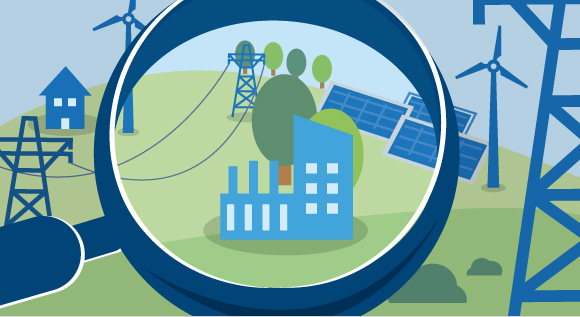What does ‘Efficiency First’ actually mean?
‘Efficiency First’ is the new principle for the energy transition. To learn more about the reasons why energy efficiency is a top priority and what this term comprises, please read on.
 © BMWi
© BMWiThis is what it’s all about: Energy: making more out of less
People who use wood, geothermal energy or solar energy for heating their homes are acting in a more climate-friendly manner than people who use fossil fuels. However, in order to be truly energy-efficient, a home not only needs to have its own renewable energy installation, but also good thermal insulation. This will reduce the overall need for heating energy. And this is the idea behind the term ‘efficiency first’ which is the new principle for the energy transition. The cleanest and cheapest energy is energy that does not have to be produced in the first place. After all, lower consumption also means that less money needs to be spent on generating of electricity and heat, on the grid, and on storage.
‘Efficiency first’ can therefore be best understood as meaning ‘prioritising energy efficiency’ and doing so wherever measures to raise energy efficiency are economically cheaper than providing energy. Thus ‘efficiency first’ applies to every area where energy is consumed – not just buildings, but also industry and transport, for example. Existing potential for increasing energy efficiency need to be better tapped and, at the same time, energy consumption also needs to be significantly reduced.
The energy transition triad
Second principle: the greatest share of the energy that we still need after we have done all that we can to improve efficiency is to be generated using renewables. This means that expanding renewable energy continues to be a key instrument in the energy transition. Wherever possible, solar or geothermal heat should be used in the place where it is generated, so as to avoid the costs of converting this energy into electricity, of storing it, and transporting it over long distances.
Third principle: in cases where renewable energy cannot be used directly, green electricity is to be used comprehensively across the heating, transport and industrial sectors – in the most energy-efficient way possible. These three elements – efficiency first, the direct use of renewables, and sector coupling – come together to form the energy transition triad.
The German government laid a focus on energy efficiency back in 2014, when it published its National Action Plan on Energy Efficiency (NAPE). Last year, the Federal Ministry for Economic Affairs and Energy published a Green Paper on energy efficiency, launching a dialogue process aimed at developing a strategy for reducing energy consumption in Germany. On top of this, the Federal Ministry for Economic Affairs and Energy has also launched an information drive entitled ‘Germany makes it efficient’, which is to help people understand the simple steps that they can take to become more energy efficient. The campaign website (in German only) offers tips for private households, companies, and the municipalities on how to raise their energy efficiency and lower their energy costs.
A principle with potential
The vast impact which ‘efficiency first’ can have was shown in a 2014 study published by economic research company Prognos and the Institut für Elektrische Anlagen und Energiewirtschaft (Institute for Electrical Installations and the Energy Sector). If the Federal Government’s energy strategy is implemented consistently, more than €12 billion will be able to be saved on energy generation and the costs associated with the grid.

